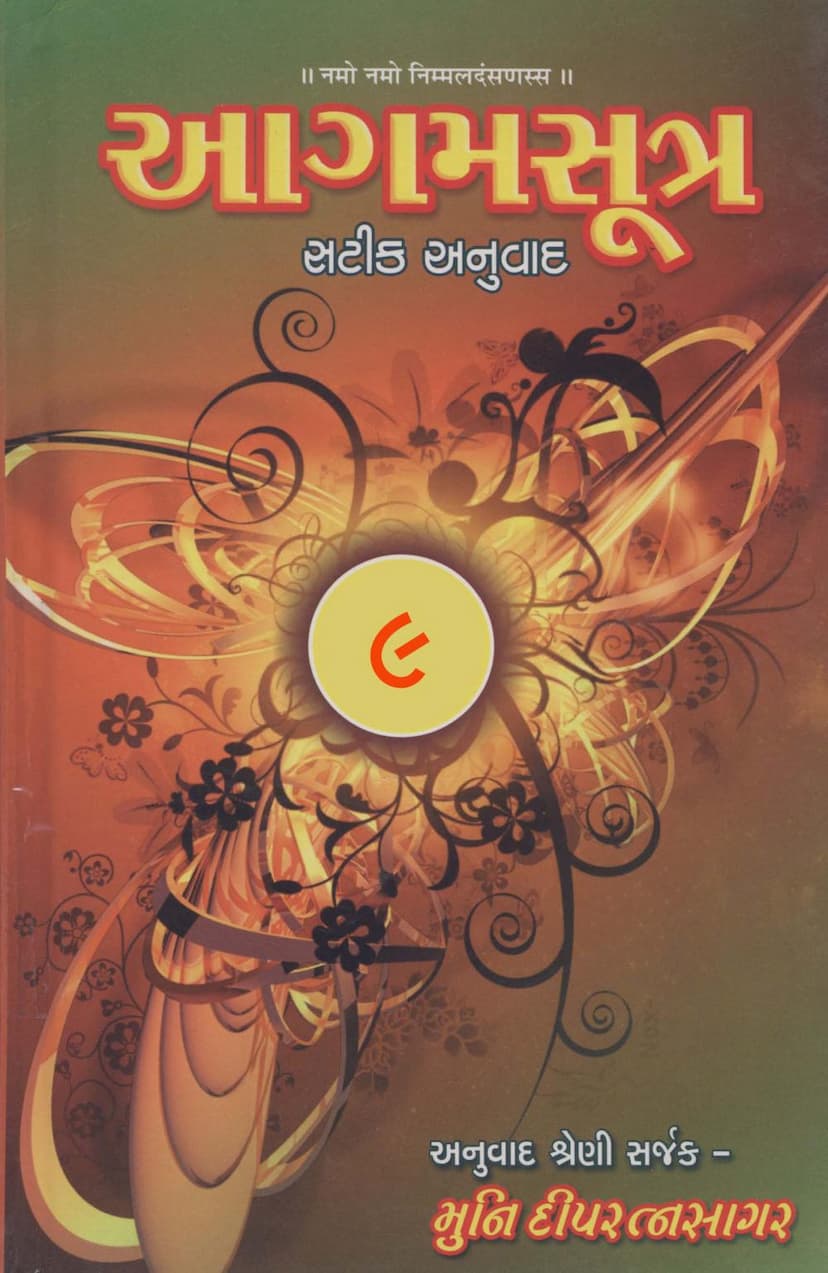Agam Satik Part 09 Bhagavati Sutra Gujarati Anuwad 1
Added to library: September 1, 2025

Summary
The provided text is Volume 9, Part 1 of the Agam Satik Anuawad, focusing on the Bhagavati Sutra (also known as Vyavaharpannatti or Visheshavasyakabhashya). It is a Gujarati translation and commentary of this significant Jain scripture, created by Muni Diperatnasagar.
Here's a breakdown of the content based on the provided pages:
Introduction and Acknowledgements:
- Title and Author: The text is identified as "Agam Sutra Satik Anuawad, Bhag 9," specifically the first part of the Bhagavati Sutra. The author is Muni Diperatnasagar.
- Invocations: The text begins with traditional Jain invocations, paying homage to Netminath, the immaculate vision, and spiritual gurus like Shri Anand, Kshama, Lalit, Sushil, and Sudharmasagar.
- Publisher and Contact: The publisher is Deepratnasagar, and the contact information for "Agam Aradhna Kendra" in Ahmedabad is provided, along with printing and typesetting details.
- Dedication and Inspiration: The translation is dedicated to the memory of Pujya Acharya Shri Hukamchand Surishwarji Maharaj, whose inspiration and vision were crucial. The publication is also financially supported by the Shri Athwalines Jain Shvetambar Murti Pujak Sangh and the Shri Seth Phoolchand Kalyanchan Trust, Surat, as well as other trusts and sanghs.
- List of Contributors: Several pages are dedicated to acknowledging the financial and spiritual support from various Jain sanghs, trusts, and individuals who contributed to the publication of this series of Agam Satik Anuawad. This highlights the collaborative effort behind the project.
- Overview of Publications: The text also includes a detailed list of other publications by Muni Diperatnasagarji, covering various aspects of Jain literature, including:
- Original Agams: Printed in separate books for ease of reading and memorization.
- Agam Gujarati Anuawad: A prose translation of the Agams for wider accessibility.
- Agam Sutra Satik: A comprehensive commentary on the original Agams, including niyuktis, vrittis, and commentaries.
- Agam Vishay Dalil: An index of Agamic topics.
- Agam Shabdkosh: An Agam dictionary with word meanings and references.
- Agam Namkosh: A dictionary of names and characters mentioned in the Agams.
- Agam Sutra Hindi Anuawad: A Hindi translation of the Agams.
- Agam Kathaanuyog: A compilation of stories and narratives from the Agams.
- Agam Mahapujan Vidhi: Rituals for Agam worship.
- Other Literature: Grammar, Vyakhyan (discourses), Tattvabhyas (study of principles), Aradhana (devotional practices), Vidhi (rituals), Pujanan (worship), Yantra (diagrams), Jinbhakti (devotion to Jin), and miscellaneous literature.
Introduction to the Bhagavati Sutra:
- Position in Angas: The Bhagavati Sutra is identified as the fifth Anga-sutra in the Jain canon.
- Alternative Names: It is known as "Viyaha-pannatti" or "Vivahapannatti" in Prakrit and "Kavanti" or "Sthaparti" in Sanskrit.
- Structure: It has one Shruta-skandha with 41 Shatakas (chapters or sections), which also contain sub-sections (Udeshakas).
- Main Subject: The primary focus of the Bhagavati Sutra is the discussion of "Swasamay" (one's own doctrine) and "Parasamay" (other doctrines). It comprises dialogues between Bhagwan Mahavir and his disciples (like Indrabhuti Gautama, Agnibhuti, Vayubhuti), as well as questions posed by gods, laymen, and laywomen, followed by Bhagwan's insightful answers.
- Content: While primarily focusing on Dravy-anuyoga (the science of substances), it also encompasses other branches of Jain philosophy like Karma-anuyoga, the description of death, transmigration, existence of entities, action, matter, suffering, different types of hellish beings, renunciation, the cosmos, and language.
- Translation Approach: The translator has provided a literal translation of the original Sutras and a commentary based on the "Tika" (commentary), sometimes referencing the "Bhagavati-Churni" (a deeper commentary). Sections of grammar, logic, and debates have been omitted (marked with X - X -).
Beginning of the Translation and Commentary (Sutra 1 onwards):
- The initial Sutras: The text begins with the traditional five-part Namaskar Mahamantra ("Namo Arihantanam," "Namo Siddhanam," etc.).
- Commentary on Sutra 1: The commentary explains the significance of bowing to the Arihants, Siddhas, Acharyas, Upadhyayas, and all Sadhus, elaborating on the meaning and attributes of each category of perfected beings.
- Introduction of Brahmi Lipi: Sutra 2 mentions Namokar to Brahmi Lipi, which is explained as the script taught by Rishabhdev to his daughter Brahmi.
- First Shataka and Udeshakas: The text then states that the first Shataka (chapter) of the Bhagavati Sutra contains 10 Udeshakas (sections within a chapter). The first Udeshaka is named "Chalan" (movement).
- Sutra 3: The third sutra lists the 10 Udeshakas of the first Shataka: Chalan, Dukh, Kakshapadosh, Prakriti, Prithvi, Yavat Nairayik, Baal, Guruk, and Chalana.
- Commentary on Udeshakas: The commentary begins to explain the meaning of these Udeshakas, starting with the first one related to "Chalan" (movement), and then proceeds to "Dukh" (suffering), "Kakshapadosh" (faults related to attachment/desire), "Prakriti" (nature of karma), "Prithvi" (earth element), and so on. It delves into the specific questions asked by the disciples and the detailed explanations provided by Bhagwan Mahavir.
- The text continues to explain the content of subsequent Udeshakas, detailing the nature of suffering, karmic principles, the realms of existence (like hellish beings), human and divine beings, the concepts of time, space, and the soul. The commentary is meticulous, often explaining the etymology of terms and providing philosophical interpretations.
In essence, Volume 9, Part 1 of Agam Satik Anuawad (Bhagavati Sutra Gujarati Anuwad 1) is a scholarly and devotional rendering of a crucial Jain scripture, making its complex teachings accessible to Gujarati-speaking followers. It meticulously translates and explains the foundational principles of Jainism as presented in the Bhagavati Sutra, covering a wide array of philosophical, cosmological, and ethical topics. The extensive acknowledgements demonstrate the significant effort and community support involved in such a monumental task of preserving and disseminating Jain knowledge.